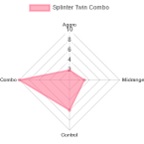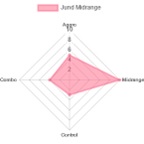Hello and welcome back to another edition of "Cube Stuff Inc." Today we are building on the Comprehensive Cube Archetype List by discussing the Theater of Combo/Synergy. This broad topic will serve as the foundation for future, more specific articles on Combo/Synergy archetypes, and is a great tool for anyone looking to build their first Cube. For the sake of simplicity, all future articles will refer to each distinct strategy simply as "Combo." But today we will discuss the distinctions that make them different.
It would be a grave injustice to the complexity of Magic: The Gathering to claim that every deck falls neatly into one of the four major Theaters discussed in these articles. A better explanation can be credited to my friend and fellow Cube enjoyer Mike, who suggested we visualize this dynamic using a Radar Graph. Every deck you construct and every archetype you support will earn different ratings in each category based on how they are trying to win the game.
A few popular Archetypes might have graphs that look like this:
 |  |  |  |
Let's assume that Aggro wants to win the game quickly and efficiently. Control wants to win the game slowly and precisely. Midrange values cards that are individually powerful and flexible. Combo & Synergy want to combine cards for extra, sometimes unintended value. (Splinter Twin) Combo and "Spells Matter" both want to combine cards to win, but each go about it slightly differently.
Combo Examples
These decks attempt to combine two or more cards to end the game quickly or at the very least bend the rules of Magic the Gathering in a meaningful way. The classic example of this strategy combines Kiki-Jiki, the Mirror Breaker or Splinter Twin with Pestermite or Deceiver Exarch to create a near infinite number of hasty creature tokens to attack your opponent and kill them on the spot. While this strategy might include cards that dip into the other Theaters, its main goal is to assemble this combo as reliably and safely as possible. This means it wants card draw and counterspells just like a Control deck to help it find its combo consistently and protect it once assembled.
Another popular Combo revolves around the card Renimate. In short, by using cards like Entomb you can put large creatures like Griselbrand into your graveyard. Then cards like Reanimate allow you to put those large creatures onto the battlefield without paying their casting cost. While this Combo does not end the game instantly the way Splinter Twin does, it "cheats" on Griselbrands casting cost and allows you to resolve a large creature much earlier than is usually allowed.
Synergy Examples
Where Combo decks attempt to bend and break card interactions, Synergy decks work within the rules as intended. One of my personal favorite Synergy based Archetypes is called "Spells Matter." Simply put, it rewards you for casting noncreature spells. Whether you are playing Balmor, Battlemage Captain to grow your entire team or Kessig Flamebreather to slowly ping an opponent to death, it turns trivial cards like Lava Spike and Think Twice into genuinely threatening cards.
Another popular Synergy based Archetype is called Aristocrats. It looks to take advantage of sacrifice effects and small replaceable creatures that reward you for letting them die. Goblin Bombardment is a useful enchantment that becomes backbreaking with a token producer. Village Rites is a generally undesirable draft pick, but when you have cards like Hunted Witness and Blood Artist in play it provides an extreme amount of value without breaking the usual rules of Magic.
The Differences
Due to the length of Magic The Gathering's existence and complexity of the cards printed, unintended card combinations occur that bend and sometimes break the principles of the game. For instance, if you want to attack with a big creature like Draco you need to pay at least 6 mana and wait a turn to do so. When WotC printed Sneak Attack they bent those rules slightly and included some safeguards to prevent its abuse. As time went on and WotC printed more and more powerful creatures, we eventually got to a point where Sneak Attack allowed you to completely break the principles of the game by resolving cards like Emrakul, the Aeons Torn. Another great example of Magic's longevity leading to complexity is Chain of Smog an unimpressive discard spell that saw virtually no play until the printing of Witherbloom Apprentice 20 years later created an opportunity to instantly drain your opponent of all their life. Combo decks generally lean into these interactions and try to bend and break the unspoken rules of Magic: The Gathering, whereas Synergy decks take cards to their limit while staying within those boundaries.
Claiming that Synergy decks are just "fair" versions of Combo decks underestimates the power and resilience of these strategies. Of course, Combo decks are more explosive than Synergy decks but they are also much more fragile. Because the individual card quality of Synergy decks is generally lower, you are much more likely to get relevant pieces passed to you later in a draft, meaning that the deck is much more likely to actually come together. Secondly, because Synergy decks often include multiple cards working in tandem it is harder to disrupt. A single Thoughtseize against a Combo opponent can end the game before it starts, however against a Synergy opponent your selection might not be as clear or as valuable.
For the sake of simplicity, I will be referring to both styles simply as Combo in my future articles. Though, as this article hopefully clarified, each strategy has enough differences that make them distinct and worth discussing separately when getting into the weeds of how certain decks play. Let me know your favorite synergies and combos over on Instagram and I'll make sure to talk about them as we continue our series into the comprehensive Cube archetype list.
Check out the other articles in this series here: The Comprehensive Guide to Cube Archetypes


























